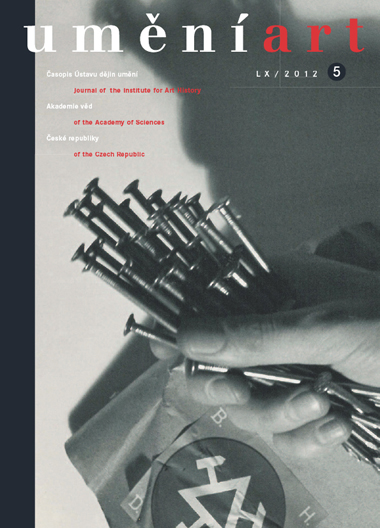Igor Fogaš - Ivo Hlobil
Oplakávání od brněnských minoritů: restaurování a interpretace
Restoration work on the late gothic Mourning of Christ (ca 1500) belonging to the Franciscans in Brno is nearing completion. The large wood carving is made out of four solid blocks of linden wood and several small additional pieces. The full depth of the relief is expressively carved. Restoration work revealed that in places the relief had been altered for ideological reasons. The body of Christ was originally covered by the mantle of the Virgin. At the wishes of an unknown 'reviser', probably sometime in the Baroque period, the mantle was remodelled with plaster to make it look like Christ's own garment. In 1999 Kaliopi Chamonikola highlighted the grandness of the composition with its twelve figures. She dated it to around the year 1510. She identified Albrecht Dürer's print The Turkish Family (B. 85) as the model for the man with the turban on the left side of the relief. It is of course also astonishing to find that the Franciscans in Brno agreed with Dürer's unusual approach of placing the figure of Christ directly on the ground without a sheet beneath him (see Dürer's Mourning of the Dead Christ from The Great Passion). It is from there also that the Brno relief borrowed the veiling of Christ's body with the Virgin's scarf. A third similarity is that like Dürer's print B. 13 the Brno relief portrays Christ with smoothly shaved temples (unlike in Dürer's other prints), thus rejecting this reminder that Jesus was a Jew. He moreover added five more figures than in Dürer's print. Twelve is the largest number of figures in any late Gothic central European relief of the Mourning. And there are other thematic innovations. Because of the tension placed on Christ's body before the Crucifixion the insteps of Christ's feet are depicted as swollen below the nail rather than above, as gravity would have dictated. Rare surviving Crucifixes with this detail are most often found among the sculptural work of Veit Stoss. The Dürer print provides an indication of the date after which the Brno relief could have been created. Dürer's Turkish Family (B. 85) is usually dated to around 1496, The Mourning B.13 to around 1497-1498, and the Great Passion as a whole was completed in 1510-1511. A dating of the Brno relief to around 1500 means it can be deemed the first ever Czech example of the use of Dürer's print as a model.
Full-text in the Digital Library of the Czech Academy of Sciences:
https://kramerius.lib.cas.cz/uuid/uuid:9f50626e-ae7b-00ec-d625-47192065b614
< back

